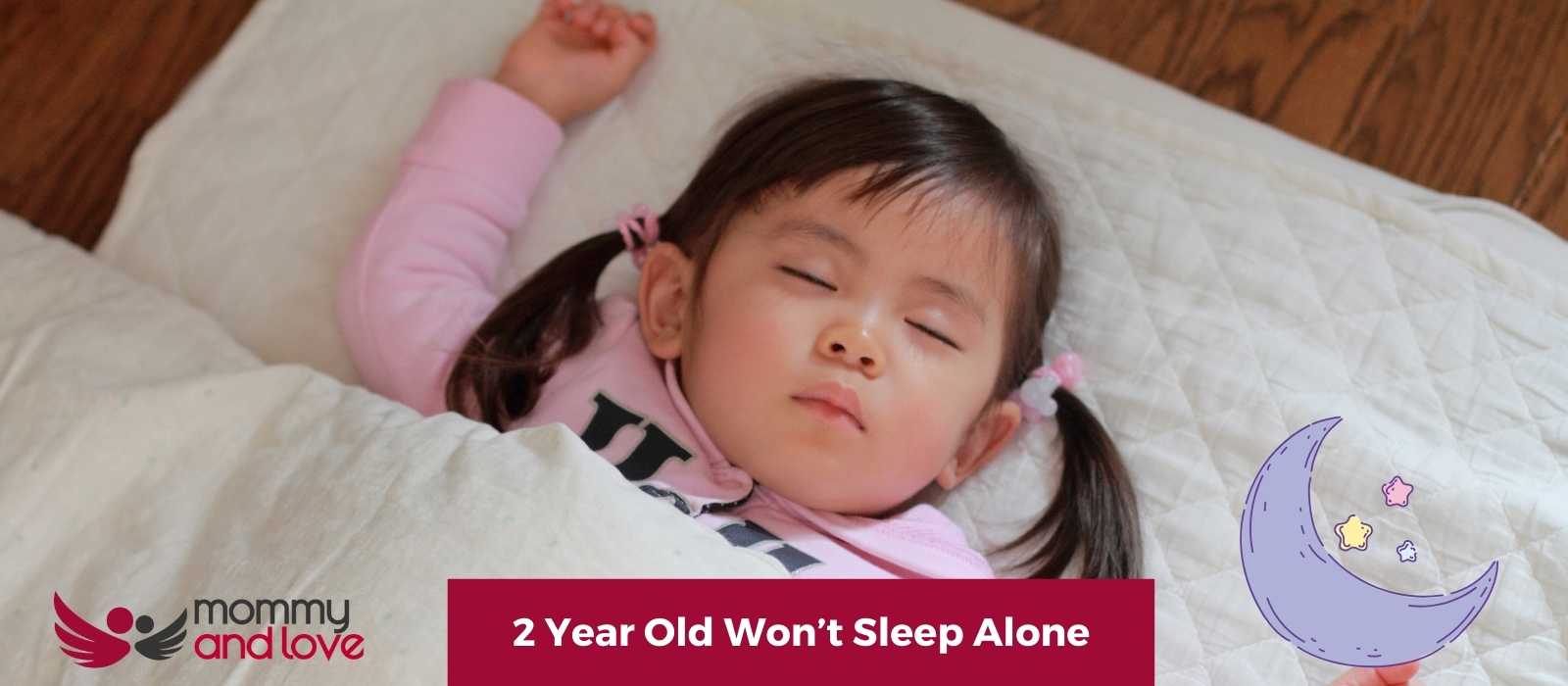Many parents struggle with getting their 2-year-old toddler to sleep alone in their own bedroom. It can be a real challenge to get them to transition from sleeping with mommy and daddy to sleeping alone.
Some 2-year-olds may not like sleeping alone because they are afraid of the dark, they may be uncomfortable in their room, or they may miss their parents. Some toddlers may also cry and become agitated when they are placed in their room to sleep, even if they have been doing well with this routine up until that point.
Do 2-Year-Olds Need to Fall Asleep Alone At Night?
Most kids this age should be sleeping in their own rooms at nap time and bedtime. Most parents would agree that it’s important for a 2-year-old to learn how to fall asleep on their own. And here are the reasons why they’re right:
- Sleeping alone at bedtime can help children become more independent. When they’re able to sleep in their own bed, they’re able to figure out how to comfort themselves and fall asleep on their own. This can be really helpful when they start school, need to get used to sleeping in a new house without mom or dad there, or when the family is expecting a new baby.
- For many children, sleeping alone at bedtime is the key to developing the ability to self-soothe. When they are tucked in their own beds, with their own pillows and blankets, they learn how to comfort themselves. This is an important skill that can help them through difficult times both during childhood and later in life.
- By encouraging kids to nap and sleep independently or stay in bed alone, parents can help their kids learn how to solve problems and handle difficult situations on their own. In addition, sleeping alone gives children a sense of autonomy and responsibility. They learn that they are capable of taking care of themselves, and this can boost their self-confidence.
- When children are exposed to darkness and silence while being alone in their own room, they learn to self-soothe and cope with their fears. As a result, they are less likely to have nightmares or be afraid of the dark when they grow up. Sleeping alone also encourages children to be independent and self-reliant.
- Knowing how to sleep without assistance can help many toddlers overcome sleep regression when it happens. Sleep regression usually occurs at age 2 and lasts for a few weeks. If you’ve trained your toddler to be an independent sleeper, you don’t have to worry about sleepless nights.
How Do Make a 2-Year-Old Child Fall Asleep Alone At Bedtime?
A good night’s sleep is important for toddlers. It helps them to get the rest they need to grow and develop. However, sometimes it can be hard for toddlers to get a good night’s sleep especially if you are trying to train them to be independent sleepers.
Yes, it can be tough to get a child to sleep through the night. They may be used to sleeping in a crib, but now that they’re a little older, it’s time for them to sleep in their own bed.
Here are a few tips to help you teach your child how to sleep independently:
- Talk to your child about sleeping in their own bed and why it’s important. You can talk to her about it and explain that she will be safe in her own bed. Let her know that you will still be close by if she needs anything.
- When you put your toddler or baby to sleep in her own bed, you will still be nearby if they wake up and need you. Tell her this before you leave the room. If your child wakes up and is crying for you, come back to her as soon as possible. Try to stay calm and reassuring until the crying is gone.
- If you want your toddler to learn how to sleep in her own sleep space, it is important to have a bedtime routine such as a warm bath, brush teeth, and storytime that you stick to every night. This will help your child know when it is time to go to sleep and make it easier for them to drift off.
- Make your toddler’s room dark, cozy, and inviting. Bright lights can be stimulating so put up some curtains or blinds to block out any outside light, and make sure the temperature is comfortable. You might also want to consider playing some soft music or investing in a white noise machine.
- If you’re finding it difficult to get your child to sleep on her own, you may want to consider sleeping on the floor in their room instead. This way, they’ll have the reassurance of your presence without being able to actually share a bed. Although it may take some adjustment, this arrangement can eventually help you child feel more comfortable sleeping independently.
- Put your toddler to bed awake but sleepy. You can stay in the room for a few minutes as she drifts off to dreamland.
- If your toddler refuses to go to bed in his own room due to separation anxiety, negotiate to keep the bedroom door open while she sleeps.
- For each night that your child stays in her bed all night, give her a small reward, such as a sticker or a piece of candy. You can also let her choose an activity to do the next day, such as going to the park or choosing a new book to read.
- Make the transition to sleeping alone gradually. Start by setting one or two days of the week when your child will be sleeping alone, and see how he reacts. If he does well, you can gradually increase the number of nights. But if he seems to be struggling, it’s okay to give him a little more time.
- There are a few different methods you can use to encourage your child to sleep alone at bedtime. However, it is important to be patient and consistent with your approach, as this will help your child to learn that sleeping alone is safe.
Would It Help the Child to Sleep Alone if the Parent Is in the Room as She Falls Asleep?
One of the most important things parents can do to make their child’s transition to going sleeping alone is to stay in the child’s room as she is falling asleep. This helps the child feel safe and secure, and it also gives the parent a chance to provide reassurance and support.
Additional Tips on Getting a 2 Year Old to Sleep on Her Own
- A child’s bedtime routines make her feel safe and fall asleep easily. If your child is having sleep problems or if you are always having bedtime battles, settling on a bedtime routine can help tremendously.
- Remove all electronic devices that can cause distractions and hand your child her favorite stuffed animal instead. Stuffed animals can be soothing and make toddlers feel secure so that they can fall asleep without their parents’ help.
- Giving in to your child’s demands will only make your bedtime problems worse. Try to tackle nighttime sleep issues with a clear mind and a positive attitude.
- How much sleep your child needs depends on her age. What’s considered adequate sleep and a child’s sleep needs will change as she grows older. So, it’s important to keep an eye on how much rest she’s getting.
- If your baby isn’t tired at bedtime, give her some quiet time while in her bed. Read stories with your baby or sing a lullaby together until she’s tired enough to go to bed.
- If your child is constantly having night terrors while in her own room at bedtime, consider doing your sleep training during her daytime naps instead.
Conclusion on 2-Year-Old Toddler Won’t Sleep Alone At Night
Although it can be a challenging process, transitioning your toddler from sleeping with you to sleeping alone is an important step in their development. By following these tips in helping your child to sleep in her own room, it’s only a matter of time before she becomes an independent sleeper.

This article was written by: Gian MIller – Full-Time Writer, Baby Whisperer & Dad of 3.
Gian spends a lot of his time writing. A self-proclaimed baby whisperer, Gian has been through it all with his own children and is passionate about sharing his hard-won wisdom with other parents. When he’s not writing or changing diapers, you can find him playing the guitar or watching baseball (or preferably both at the same time).




